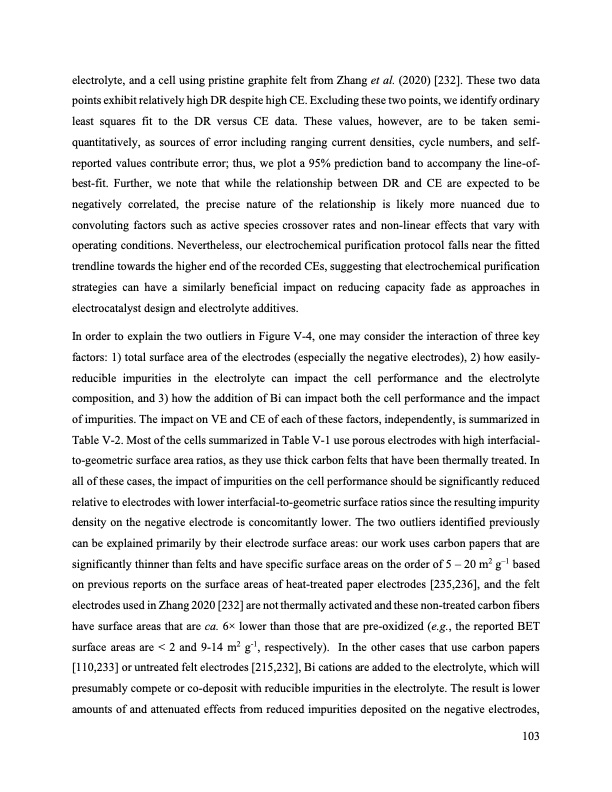
PDF Publication Title:
Text from PDF Page: 103
electrolyte, and a cell using pristine graphite felt from Zhang et al. (2020) [232]. These two data points exhibit relatively high DR despite high CE. Excluding these two points, we identify ordinary least squares fit to the DR versus CE data. These values, however, are to be taken semi- quantitatively, as sources of error including ranging current densities, cycle numbers, and self- reported values contribute error; thus, we plot a 95% prediction band to accompany the line-of- best-fit. Further, we note that while the relationship between DR and CE are expected to be negatively correlated, the precise nature of the relationship is likely more nuanced due to convoluting factors such as active species crossover rates and non-linear effects that vary with operating conditions. Nevertheless, our electrochemical purification protocol falls near the fitted trendline towards the higher end of the recorded CEs, suggesting that electrochemical purification strategies can have a similarly beneficial impact on reducing capacity fade as approaches in electrocatalyst design and electrolyte additives. In order to explain the two outliers in Figure V-4, one may consider the interaction of three key factors: 1) total surface area of the electrodes (especially the negative electrodes), 2) how easily- reducible impurities in the electrolyte can impact the cell performance and the electrolyte composition, and 3) how the addition of Bi can impact both the cell performance and the impact of impurities. The impact on VE and CE of each of these factors, independently, is summarized in Table V-2. Most of the cells summarized in Table V-1 use porous electrodes with high interfacial- to-geometric surface area ratios, as they use thick carbon felts that have been thermally treated. In all of these cases, the impact of impurities on the cell performance should be significantly reduced relative to electrodes with lower interfacial-to-geometric surface ratios since the resulting impurity density on the negative electrode is concomitantly lower. The two outliers identified previously can be explained primarily by their electrode surface areas: our work uses carbon papers that are significantly thinner than felts and have specific surface areas on the order of 5 – 20 m2 g–1 based on previous reports on the surface areas of heat-treated paper electrodes [235,236], and the felt electrodes used in Zhang 2020 [232] are not thermally activated and these non-treated carbon fibers have surface areas that are ca. 6× lower than those that are pre-oxidized (e.g., the reported BET surface areas are < 2 and 9-14 m2 g-1, respectively). In the other cases that use carbon papers [110,233] or untreated felt electrodes [215,232], Bi cations are added to the electrolyte, which will presumably compete or co-deposit with reducible impurities in the electrolyte. The result is lower amounts of and attenuated effects from reduced impurities deposited on the negative electrodes, 103PDF Image | Bringing Redox Flow Batteries to the Grid

PDF Search Title:
Bringing Redox Flow Batteries to the GridOriginal File Name Searched:
Rodby-krodby-phd-chemE-2022-thesis.pdfDIY PDF Search: Google It | Yahoo | Bing
Salgenx Redox Flow Battery Technology: Salt water flow battery technology with low cost and great energy density that can be used for power storage and thermal storage. Let us de-risk your production using our license. Our aqueous flow battery is less cost than Tesla Megapack and available faster. Redox flow battery. No membrane needed like with Vanadium, or Bromine. Salgenx flow battery
| CONTACT TEL: 608-238-6001 Email: greg@salgenx.com | RSS | AMP |